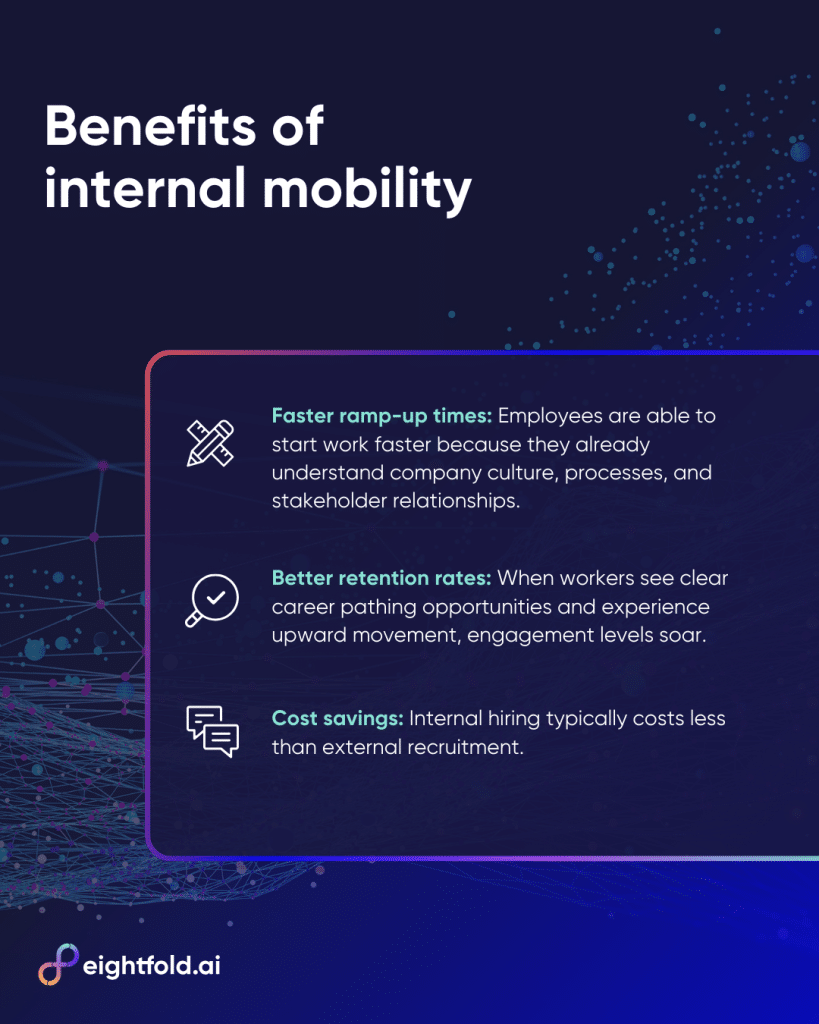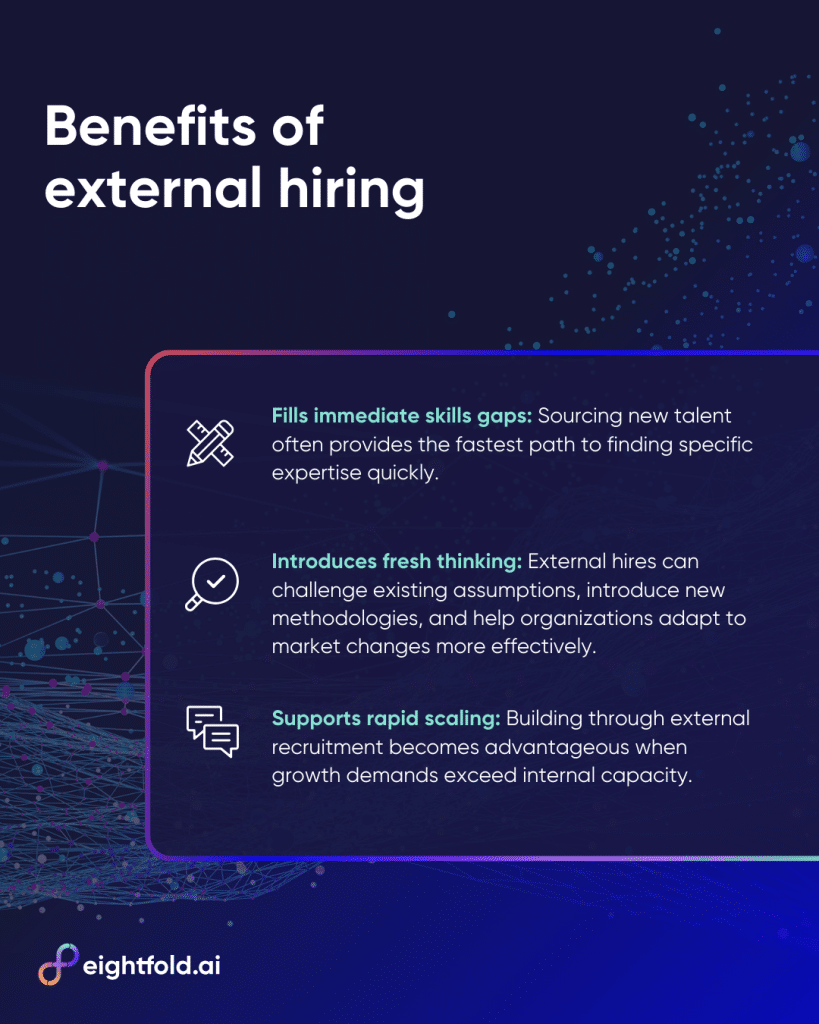- Balancing internal mobility and external hiring is key — both approaches bring unique strengths for long-term growth, from faster ramp-up times to fresh skills and perspectives.
- Recruiters are now strategic talent advisers, guiding when to promote from within versus when to bring in new talent based on business needs, culture, and skill gaps.
- Agentic AI transforms both paths, proactively surfacing candidates, benchmarking options, and automating analysis to drive smarter, faster, data-driven hiring decisions.
Recruiters face unprecedented pressure to balance speed, quality, and long-term value in today’s competitive talent landscape. With hiring costs soaring and retention rates fluctuating, the stakes have never been higher for making the right talent decisions.
This reality forces HR teams to confront a fundamental question that shapes every recruitment strategy: Should we prioritize internal mobility by developing existing talent, or focus on external hiring to bring in fresh perspectives and skills?
The answer isn’t straightforward. Both approaches offer distinct advantages and present unique challenges that can significantly impact your organization’s talent acquisition strategy and long-term growth trajectory.
More importantly, the emergence of AI recruiting tools — particularly agentic AI — is revolutionizing how we approach internal and external talent strategies.
This post will provide a comprehensive comparison of internal mobility versus external hiring, examining when each approach delivers optimal results. We’ll explore how AI technology, especially intelligent agents that can proactively identify opportunities and automate complex tasks, can enhance both pathways to create more effective, data-driven recruitment strategies.

Internal mobility: Growing talent from within
Internal mobility encompasses the strategic movement of employees within an organization through promotions, lateral moves, cross-functional transfers, and targeted upskilling initiatives. This approach treats your existing workforce as a rich talent pool, ready to be developed and repositioned to meet evolving business needs.
The strategic benefits of internal hiring
The advantages of promoting from within extend far beyond simple cost savings. Employees who advance internally typically experience faster ramp-up times because they already understand company culture, processes, and stakeholder relationships. This institutional knowledge proves invaluable, particularly in complex or highly regulated industries where context matters significantly.
Internal mobility also drives impressive employee retention outcomes. When workers see clear career pathing opportunities and experience upward movement, engagement levels soar.
Organizations that lead on internal hiring practices report 53% longer employee tenures, according to LinkedIn. This creates a positive cycle where top performers stay longer, reducing the constant need for external recruitment.
From a financial perspective, internal hiring typically costs less than external recruitment, which SHRM estimates can cost three to four times the position’s salary, when factoring in sourcing, interviewing, and onboarding expenses.
Additionally, internally promoted employees often demonstrate better culture fit and require less time to reach full productivity.
Casey Smith, Senior Manager of Career Development at Twilio, shares how focusing on internal mobility is transforming their organization. Learn more in this blog post.
Navigating the challenges
However, internal mobility isn’t without limitations. The most obvious constraint is the finite talent pool — you can only work with existing skills and capabilities. This limitation becomes particularly acute when organizations need specialized expertise that doesn’t exist internally or when rapid scaling demands exceed internal capacity.
Internal hiring can also create equity concerns if not managed transparently. Employees may perceive favoritism or question whether advancement opportunities are fairly distributed. Without proper career-pathing systems, high-potential employees might feel stuck, leading to the very retention problems internal mobility aims to solve.
Perhaps most critically, overreliance on internal hiring can lead to skill stagnation and reduced innovation. When teams primarily consist of people with similar backgrounds and experiences, creative problem-solving and fresh perspectives may suffer.
When internal mobility works best
Internal mobility thrives in organizations with robust learning and development programs and transparent career advancement frameworks. Businesses that invest heavily in upskilling initiatives and maintain clear competency models typically see the greatest success with internal hiring strategies.
This approach works particularly well for leadership development, where cultural alignment and institutional knowledge prove crucial for success.

External hiring: Bringing in fresh talent
External recruitment involves sourcing, attracting, and hiring candidates from outside the organization to fill open positions. This approach prioritizes accessing new skills, perspectives, and experiences that may not exist within the current workforce.
The power of external recruitment
External hiring excels at filling immediate skills gaps, particularly in rapidly evolving fields like technology, digital marketing, or data science. When organizations need specific expertise quickly, sourcing new talent often provides the fastest path to capability building. External candidates bring diverse experiences, industry best practices, and innovative approaches that can catalyze organizational change.
This approach proves especially valuable during transformation initiatives or innovation pushes where fresh thinking becomes essential. External hires can challenge existing assumptions, introduce new methodologies, and help organizations adapt to market changes more effectively.
For businesses expanding into new markets or launching new product lines, recruiting fresh talent with relevant experience often proves indispensable.
External hiring also supports rapid scaling efforts. When growth demands exceed internal capacity, building through external recruitment becomes not just advantageous but necessary for maintaining competitive positioning.

Learn more about how Forvia is staying at the forefront of automotive technology by hiring externally using AI-powered platforms.
Managing external hiring challenges
The primary drawbacks of external recruitment center on time, cost, and integration risks. External candidates typically require longer onboarding periods to understand organizational culture, processes, and stakeholder relationships. This extended ramp-up time can impact immediate productivity and delay project timelines.
Cultural adjustment represents another significant risk. Even highly skilled external hires may struggle to integrate effectively, leading to reduced performance or early turnover. Forbes says employees who feel connected to their organization’s culture are four to six times more likely to be engaged at work and six times more likely to recommend their workplace to others.
Financial considerations also weigh heavily. External hiring often involves higher compensation packages, extensive recruiting costs, and substantial onboarding investments. When external hires don’t succeed, these sunk costs can significantly impact recruitment budgets and team morale.
Optimal external hiring scenarios
External recruitment works best when organizations face genuine skills gaps that cannot be addressed through internal development within required timeframes. This approach proves particularly effective during periods of strategic transformation, market expansion, or when introducing new technologies that require specialized expertise.
Businesses in highly competitive industries often rely on external hiring to access top talent and maintain innovation momentum.
Internal vs. external: A strategic comparison
Understanding when to prioritize internal mobility versus external hiring requires careful analysis across multiple dimensions:
- Time to productivity: Internal candidates typically reach full productivity faster than external hires due to existing institutional knowledge and established relationships. However, external candidates may bring immediately applicable specialized skills that internal candidates would need months to develop.
- Cost per hire: Internal mobility generally costs significantly less, with total expenses often coming in lower than external recruitment. However, this calculation must include potential upskilling investments and opportunity costs of moving existing employees.
- Retention impact: Internally promoted employees demonstrate higher retention rates and engagement levels. External hires face higher turnover risks during their first 18 months but may bring longer-term career stability if successfully integrated.
- Culture fit: Internal candidates inherently understand organizational culture, while external hires require careful assessment and onboarding support to ensure alignment.
- Diversity potential: External hiring typically offers greater opportunities to enhance workforce diversity, while internal mobility may perpetuate existing demographic patterns without intentional intervention.
- Upskilling and future-readiness: Internal mobility builds organizational learning capabilities and creates clear development pathways. External hiring brings immediate skills but may not contribute as directly to overall workforce development.
The most effective long-term talent strategy often blends both approaches based on specific business goals, workforce readiness, and market conditions rather than defaulting to one approach exclusively.
Related content: Learn more about how agentic AI is transforming the role of the recruiter.
The recruiter’s role in balancing both approaches
Modern recruiters must evolve beyond transactional hiring to become strategic talent advisers who guide internal mobility and external recruitment decisions.
This expanded role requires deep understanding of organizational capabilities, future skill requirements, and workforce development opportunities.
Successful recruiters work cross-functionally with HR business partners, hiring managers, and learning and development teams to create comprehensive talent strategies. They maintain visibility into internal talent pools while simultaneously building external networks and market intelligence.
Strategic decision-making framework
Effective talent acquisition best practices involve developing systematic approaches to evaluate each hiring opportunity.
Recruiters should assess whether internal candidates possess foundational skills that can be developed quickly, evaluate the strategic importance of bringing in external perspectives, and consider long-term workforce development implications.
Skills-based hiring methodologies prove particularly valuable in this context, focusing on competencies and potential rather than traditional experience requirements.
This approach enables more accurate assessment of both internal and external candidates while supporting workforce development initiatives.
Common pitfalls to avoid
Many organizations fall into the trap of over relying on external hiring without fully exploring internal options. This pattern not only increases costs but also signals to employees that advancement opportunities may be limited.
Conversely, some organizations become too insular, missing opportunities to bring in valuable external expertise and perspectives.
Recruiters must also avoid neglecting visibility into internal talent capabilities. Without robust talent intelligence systems, hidden skills and development potential remain unexplored, leading to suboptimal hiring decisions.
Related content: Agentic AI is the future of HR — but not all agents are equal. Explore our guide to what true agentic AI should do in HR.
How AI — especially agentic AI — supports both paths
Artificial intelligence is transforming how organizations approach internal mobility and external hiring, offering unprecedented capabilities to more effectively identify, assess, and develop talent.
AI-powered internal mobility
AI recruiting tools excel at analyzing employee skills, performance data, and career aspirations to identify optimal internal mobility opportunities. These systems can match employees to new roles based on both demonstrated competencies and adjacent skills that indicate high potential for success in different positions.
Advanced internal mobility AI platforms provide proactive upskilling recommendations, identifying skill gaps and suggesting development pathways that align with both individual career goals and organizational needs. This capability transforms reactive career development into strategic workforce planning.
Perhaps most valuable, AI systems can surface hidden or adjacent skills that human reviewers might overlook. By analyzing project contributions, collaboration patterns, and learning behaviors, these tools reveal development potential that traditional assessment methods miss.
AI-enhanced external hiring
For external recruitment, AI hiring software streamlines sourcing by automatically identifying candidates who match specific skill requirements across multiple platforms and databases. These systems move beyond keyword matching to understand skill relationships and transferable capabilities.
Skill-based candidate ranking algorithms evaluate external candidates more objectively, reducing bias while identifying individuals with the highest likelihood of success in specific roles. Predictive analytics can assess long-term fit by analyzing factors that correlate with retention and performance success.
The agentic AI advantage
Agentic AI represents the next evolution in talent intelligence, functioning as intelligent agents that proactively identify opportunities, automate routine tasks, and collaborate with recruiters to improve decision-making. Unlike traditional AI tools that respond to queries, agentic systems anticipate needs and surface relevant insights without prompting.
Consider this scenario: An agentic AI system identifies a critical role opening and automatically analyzes internal candidates who could potentially fill the position with targeted development. Simultaneously, it benchmarks external market conditions, salary expectations, and candidate availability. The system then presents recruiters with a comprehensive analysis comparing internal mobility options against external hiring alternatives, complete with cost projections, timeline estimates, and risk assessments.
This proactive approach enables recruiters to make more informed decisions while reducing the time spent on manual research and analysis.
Eightfold CEO and Co-founder Ashutosh Garg shares how agents in HR can give recruiters back their most valuable resource: time.
Building a long-term growth strategy with the right balance
Leading organizations are increasingly adopting hybrid approaches that strategically combine internal mobility and external hiring based on specific role requirements and organizational priorities.
These businesses recognize that sustainable talent growth requires both developing existing capabilities and infusing new perspectives and skills.
Strategic evaluation framework
When evaluating each hiring opportunity, recruiters should systematically assess several key factors:
- Internal readiness: Does the organization have employees with foundational skills who could succeed in the role with targeted development? What would the timeline and investment requirements look like?
- Long-term skill needs: How does this role fit into broader workforce planning initiatives? Will developing internal capabilities in this area support multiple future needs?
- Innovation requirements: Does this position require fresh external perspectives to drive innovation, or would internal institutional knowledge prove more valuable?
- Cultural considerations: How important is immediate cultural alignment versus the potential benefits of introducing new viewpoints and approaches?
The role of AI in workforce agility
AI technology plays a crucial role in maintaining workforce agility by providing real-time insights into skill gaps, development opportunities, and market conditions. These systems enable organizations to anticipate future needs and proactively develop capabilities rather than reactively filling positions.
Future of work strategies increasingly depend on AI-powered talent intelligence to navigate complex decisions about internal development versus external acquisition. Organizations that implement these capabilities effectively can build more resilient, adaptable workforces that support long-term competitive advantage.
Skills-first hiring approaches, supported by AI analysis, enable more flexible talent strategies that prioritize potential and adaptability over traditional experience requirements. This methodology supports both internal mobility initiatives and external hiring efforts by focusing on core competencies that translate across roles and contexts.
Internal hiring vs. external hiring: What’s better?
The choice between internal mobility and external hiring shouldn’t be viewed as an either/or decision. Instead, successful talent growth strategies recognize that both approaches serve essential roles in building sustainable, competitive workforces.
Internal mobility provides the foundation for employee engagement, cultural continuity, and cost-effective talent development. External hiring brings the fresh perspectives, specialized skills, and innovative thinking necessary for adaptation and growth.
The most effective recruiters understand how to strategically balance these approaches, using data-driven insights to determine when each method will deliver optimal results. They recognize that different roles, market conditions, and organizational priorities require different talent strategies.
Agentic AI offers unprecedented opportunities to enhance both internal mobility and external hiring processes. By using intelligent systems that can proactively identify opportunities, automate routine tasks, and provide comprehensive analysis, recruiters can make more informed decisions while focusing their expertise on strategic relationship building and organizational development.
As the talent landscape evolves, organizations that master the art of balancing internal development with external acquisition — supported by advanced AI capabilities — will build the agile, skilled workforces necessary for long-term success.
Ready to explore how AI-powered talent solutions can support both your internal mobility and external hiring strategies? Book a demo to learn more.
